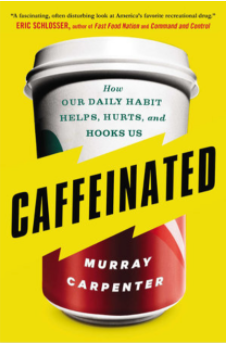
A new book, Caffeinated, by Murray Carpenter, a journalist with a master’s degree in environmental studies, focuses on the caffeine industry and how it has held the US government in check since 1909, fighting any attempt by the FDA to regulate caffeine in beverages. The story of how Coca Cola fought off early attempts to regulate how much caffeine could be put into beverages, how they then claimed it was only a flavoring ingredient, and now how they dumped that argument to jump on the “energy” drink bandwagon is fascinating and disturbing. Who knew that a small chemical company called Monsanto originally got its start extracting caffeine for Coca Cola?
History would be different if caffeine hadn’t kept it solvent in the early 1900’s. Caffeinated is filled with surprising information that Carpenter dug up including intel from his visit to China where caffeine is synthesized now in unregulated pharmaceutical plants. I bet most soda and energy consumers have no idea that their caffeine is synthetic and that synthesized caffeine has a problem with…fluorescence!
Not too excited about synthetic caffeine’s blue fluorescence? How about the solution: process it with sodium nitrite, acetic acid, sodium carbonate and …chloroform! No wonder no synthetic caffeine processing plant, not in China, India nor Germany, would allow Carpenter to tour their plant. Not one! It makes you wonder, what have they got to hide?
Natural caffeine vs. synthetic caffeine
Guess how you can tell synthetic caffeine from natural caffeine? Murray informs us that carbon dating distinguishes synthetic caffeine because it is made from urea that comes from fossil fuels, not fresh tea leaves or coffee beans. Sounds even yuckier, doesn’t it?
Of course, companies like to lie about their source of caffeine and pretend it is natural. The reality is though, there is a huge demand for caffeine. According to Murray, the US buys fifteen million pounds, or enough to fill a freight train two miles long, every year. There simply isn’t enough demand for decaffeinated coffee and tea to make that much caffeine! Plus of course, synthetic caffeine is a whole lot cheaper.
Research on the effects of caffeine
Carpenter also reviews all the best caffeine researchers and the results of their studies showing just how addictive caffeine really is. Roland Griffiths, PhD at Johns Hopkins University, has proven that: 1) people self-administer caffeine in a drug-dose dependent manner; 2) the consumption of caffeine is reinforcing the desire to consume more; 3) people build up a tolerance to it and become dependent on it; and 4) withdrawal from caffeine produces painful and debilitating symptoms.
Like lab rats who are given levers to self-administer a food or drug they like, people stand in line at Starbucks or insert K-cups into their office coffee machine to self-administer the drug, caffeine, throughout the day. Griffiths makes the point that in diverse cultures across the globe, people self-administer caffeine from a variety of plants including coffee, tea, mate, guarana, and kola nuts. Everyone insists they love the taste of whatever drug-delivery system their culture enjoys, but as Griffiths points out, “the common denominator there is caffeine”. (Carpenter 71).
Murray covers a wide array of health problems caused by consuming too much caffeine. He looks at insomnia and finds brain research showing that just 200mg of caffeine, about the amount in one 12oz mug of coffee, taken in the morning is still affecting sleep at night. The sleep of those of us who are morning people is affected the most by caffeine consumption. Caffeine doesn’t affect our dreams, but it does interfere with stage 3 and 4 sleep, the rebuild and repair phase of our sleep cycle.
Several years ago, we asked several thousand Teeccino drinkers to choose from a variety of symptoms that made them want to stop drinking coffee. Besides general caffeine sensitivity, anxiety was chosen as the biggest reasons causing people to quit coffee. It turns out that genetic research now shows that sensitivity to caffeine causing insomnia and anxiety are functions of the type of adenosine receptors we have inherited. Additionally, how fast the liver detoxifies caffeine is also the function of an inherited type of enzymatic pathway, called CYP1A2. There is a slow and fast version of this genetic pathway.
This pathway’s effects on the body are silent until a heart attack occurs. For people under the age of 59 who have the slow metabolizing version of this gene, the risk of sudden heart attack went up 24% for just 1 cup of coffee a day, 67% for 2-3 cups a day, and a whopping 133% for 4 or more cups a day. Under the age of 50, the risk increased fourfold. This research, published in JAMA, The Journal of the American Medical Association, in March 2006, was ground breaking. Yet studies on caffeine continue to ignore genetic differences instead of recognizing that subsets of people with different genotypes can respond very differently to drugs like caffeine.
Murray’s book is highly readable and contains great information for athletes who want to use caffeine as a legal drug to enhance performance. We recommend that you get a copy if you are contemplating going caffeine free!


